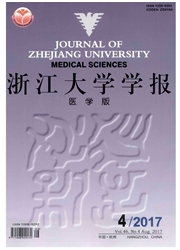

 中文摘要:
中文摘要:
目的:观察大鼠脑出血(intracerebral hemorrhage,ICH)后迟发性神经元变性的发生,小胶质细胞和核因子-kappa B(NF-κB)的激活,探讨铁离子在该过程中的作用。方法:建立大鼠脑出血模型及海马FeCl2模型,在不同时间点处死,观察神经元变性(fluoro-jade C staining,FJC染色)、小胶质细胞的激活,以及NF-κB(免疫组化染色)的表达和分布情况。结果:在2组模型中,术后14 d均发现FJC染色阳性的变性神经元。术后1 d在注射侧血肿周围及海马区,即可清晰地观察到激活的小胶质细胞和NF-κB阳性细胞,且至少持续存在14 d,而非注射侧几乎无FJC阳性细胞、激活的小胶质细胞和NF-κB阳性细胞。结论:大鼠脑出血后存在迟发性神经元变性现象,小胶质细胞的激活及NF-κB的表达可能参与了这一过程,而铁离子的潴留可能是导致这一过程的重要原因之一。
 英文摘要:
英文摘要:
Objective: To investigate the occurrence of delayed neuronal degeneration ,activation of microglia and nuclear factor-kappa B after rat intracerebral hemorrhage (ICH) and the possible role of iron. Methods: ICH model was induced by infusion of autologous whole blood into the right basal ganglia. To evaluate the possible role of iron on delayed neuron loss ,an iron model by injection of FeC12 into hippocampus was also set up. Degeneration of neurons and the activation of microglia and NF-κB were detected. Results: Both whole blood and iron caused neuron degeneration for at least 14 days were revealed by Fluoro-jade C staining. Consistently,activated microglia and NF~B positive cells were also observed in the peri-hematoma area and the ipsilateral hippoeampus. Conclusion: The iron may participate in the delayed neuron injury followed ICH; the activated microglia and NF-κB may be involved in the process of delayed neuronal injury.
 同期刊论文项目
同期刊论文项目
 同项目期刊论文
同项目期刊论文
 期刊信息
期刊信息
